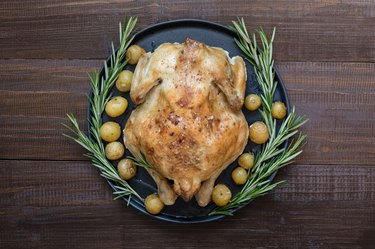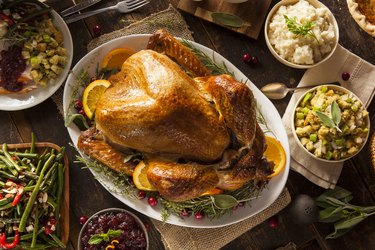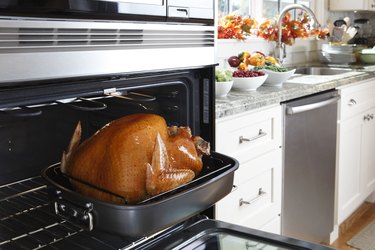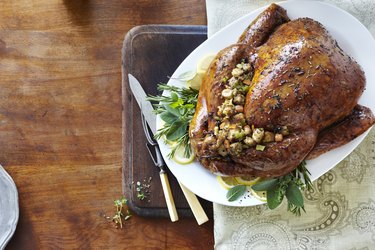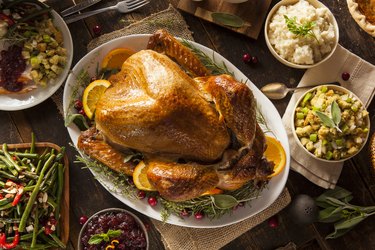
If you're looking to save time and effort, an already-cooked turkey simplifies one of the major projects involved in preparing Thanksgiving dinner. But pre-cooked doesn't mean you're off the hook entirely when it comes to preparation and food safety.
Here's what you need to know to ensure you safely heat up your ready-to-serve turkey, avoiding the spread of foodborne illness. Following directions will ensure you'll be dining on the best pre-cooked turkey possible.
Video of the Day
Video of the Day
Tip
Check the packaging on your already-cooked bird. It should come with step-by-step instructions detailing how to safely heat up the turkey.
And don't forget: This convenient option comes in more than one flavor. If you want a fully cooked smoked turkey, they're out there!
Defrosting a Ready-to-Cook Turkey
In many cases, an already-cooked turkey arrives at your home frozen — so you won't be able to immediately carve and serve it.
Instead, your first step will be to defrost the bird in the refrigerator. This takes time, so plan ahead: For every 5 pounds, it will take about 24 hours to thaw, according to the University of Tennessee Institute of Agriculture. So, a 15-pound turkey will take 3 full days to thaw out.
To thaw, keep the bird in its plastic packaging. Rest it on a cookie sheet in the refrigerator. Considering a thawed turkey can't sit in your fridge endlessly, time the process for your planned meal: Eat it within 3 to 5 days, per the University of Tennessee.
Warning
Always check the instructions on your frozen, ready-to-serve turkey. Brands may have instructions specific to their products. Butterball's fully cooked turkey, for example, suggests thawing in the refrigerator with the breast side up.
There are exceptions to the "thaw first" rule: A frozen turkey that is stuffed should not be thawed, according to the USDA.
Serving It Cold
Is a precooked turkey fully cooked? It sure is! And because the turkey is already cooked, once it's fully thawed, you're free to serve it as is. Here's how:
- Thaw the turkey, following the instructions above.
- Remove the bird from its wrapper.
- Carve and cut up the turkey. You can eat fully pre-cooked turkey in meals like sandwiches and salads.
Warning
You can eat a pre-cooked turkey cold. However, if you or your guests have compromised immune systems, avoid eating cold pre-cooked turkey meat, according to the Fred Hutch Cancer Center. Instead, heat it up to an internal temp of 165 degrees Fahrenheit before eating.
How to Cook a Ready-to-Eat Turkey
How long you cook a whole bird depends on its weight. A bigger turkey will require more time in the oven. To heat it up, follow these steps:
- Thaw the turkey, following the instructions above.
- Remove the wrapper and place the thawed, already-cooked whole turkey in a roasting pan with the breast side up.
- Brush the turkey skin lightly with olive oil and place it in an oven preheated to 375 degrees Fahrenheit. (Note: Make sure not to reheat in an oven that's cooler than 325 F, per the South Dakota State University Extension.)
- How do you reheat a precooked turkey without drying it out? Add water or broth to the bottom of the roasting pan, per a recommendation from Mahogany Smoked Meats.
- Reheat the turkey until it reaches an internal temperature of 165 degrees, according to the USDA. This time will vary, depending on your oven and the size of the bird, but you'll want to cook the turkey for about 10 minutes per pound, according to Honey-B Ham. (Keep scrolling for a reheating time chart.)
- Peek in the oven after about an hour. If the turkey's skin is over-browning, cover the entire bird with foil.
- Check the turkey with a meat thermometer starting about 30 minutes before the recommended cooking time. Insert the thermometer into the thickest part of the breast and thigh to check for doneness. Don't let the thermometer tip touch the bone, because it may be hotter than the meat. The USDA recommends cooking and reheating all poultry, including pre-cooked turkey, to an internal temperature of 165 F.
- Once the bird is fully reheated, at 165 F, remove it from the oven.
- Let it rest for about 15 minutes. Then, carve and serve.
Use this chart to estimate the cooking time on your already-cooked bird:
Turkey Weight | Servings* | Reheating Time |
|---|---|---|
10 lbs. | 8 | 1 hr 20 mins - 1 hr 40 mins |
15 lbs. | 12 | 2 hrs - 2.5 hrs |
20 lbs. | 16 | 2.5 hrs - 3 hrs 15 mins |
25 lbs. | 20 | 3 hrs 15 mins - 4 hrs 15 mins |
*1.25 pounds of turkey per person is a good guideline for hungry guests, per the National Turkey Foundation (NTF).
Make Gravy
If desired, you can use the drippings from the bottom of the roaster pan to make homemade gravy. To thicken it, mix 1 tablespoon of cornstarch per 1 cup of drippings, per the Argo Starch website.
What About Stuffing?
When it comes to stuffing and pre-cooked birds, the situation is complicated. A pre-cooked whole, stuffed turkey that has the USDA or a state mark of inspection is safe to eat, per the USDA.
But you'll want to avoid buying a pre-cooked, stuffed turkey from a local restaurant or caterer. That's because stuffing should not be prepared ahead.
Instead, you can prep the dry and wet stuffing ingredients separately and keep them in the fridge. Do not mix wet and dry ingredients until just before spooning the stuffing into the turkey cavity, per the USDA.
Spoon the stuffing in loosely — think: 3/4 cup of stuffing per pound of meat. The stuffing should be moist, because heat destroys bacteria better in a moist environment.
Tip
Use a food thermometer to make sure both bird and stuffing reach 165 degrees Fahrenheit, per the USDA.
How to Store Thanksgiving Leftovers
If you've had a long and leisurely meal, you may have fewer options for saving than you think: Any turkey, stuffing or gravy that's been at room temperature longer than 2 hours should be discarded, according to the Minnesota Department of Health.
How you store turkey leftovers is important when it comes to avoiding foodborne illness.
In the Refrigerator
- Remove the meat from the bone and slice up the breast meat, per the University of Tennessee Extension. Legs and wings are OK to refrigerate as is.
- Place leftovers in small and shallow containers, per the USDA. Doing so helps them cool in the fridge faster.
- Cover the top with plastic wrap or choose a container with a lid.
Tip
Roasted turkey should be eaten within 3 to 4 days, according to the University of Illinois Extension. That means your Thanksgiving turkey should be eaten — or composted and thrown away — by the Monday after the big holiday, per the USDA.
In the Freezer
If you want to be able to enjoy leftovers for longer, freeze them, following the same steps as the fridge method above.
As with the refrigerator, small and shallow containers are best for housing your leftovers, per the USDA.
Leftover turkey can be kept in the freezer for up to 6 months, according to the USDA.
How to Reheat Leftovers
The rule with reheating turkey — or any Thanksgiving leftover — is simple: Heat up food until it reaches an internal temperature of 165 F, according to the USDA. Use a food thermometer to check the temperature.
Frozen leftovers can be reheated without thawing them first, per the USDA. It'll just take longer than reheating thawed out foods.
Reheating Leftovers in the Oven
Follow these steps from the USDA to reheat your turkey leftovers in the oven:
- Preheat the oven to 325 F or higher.
- Place the food in an oven-safe dish. You can add broth or water to the bottom of the dish to keep it moist. Covering the dish with aluminum foil or the dish's lid will also help keep the turkey from drying out.
- Put the dish with turkey in the oven.
- Check the temperature using a food thermometer. The turkey is safely reheated and OK to eat when it reaches an internal temperature of 165 F.
Reheating Leftovers in the Microwave
Follow these steps, per the USDA:
- Place the turkey in a microwave-safe dish.
- Cover the meat, but vent the lid so steam can escape. You can add some water or stock at the bottom of the dish to keep the turkey moist.
- Microwave the turkey. Be sure to rotate it to allow for even heating. The time will vary depending on your microwave (and how much turkey you're reheating). Check the microwave manual for recommendations about cooking time and power level.
- University of Tennessee Institute of Agriculture: "Turkey Basics Handling Precooked Dinners"
- USDA: "Stuffing and Food Safety"
- South Dakota State University Extension: "Preparing Turkey for the Holidays"
- USDA: "Countdown to a Food-Safe Thanksgiving Day - FAQs"
- Honey-B Ham: "How to Prepare and Serve your Turkey"
- National Turkey Foundation: "https://www.eatturkey.org/2019/11/05/how-much-turkey-for-my-table/"
- USDA: "USDA Shares Easy At-Home Advice for Handling Food Safely this Thanksgiving"
- Minnesota Department of Health: "Turkey: Safe Thawing and Cooking"
- University of Illinois Extension: "Turkey for the Holidays"
- USDA: "Let's Talk Turkey—A Consumer Guide to Safely Roasting a Turkey"
- Fred Hutch Cancer Center: "Food Safety Class"
- Mahogany Smoked Meats: "How to Reheat a Smoked Turkey Without Drying it Out"
- USDA: "Thanksgiving Leftovers for Safe Keeping, Weekend Grazing"
